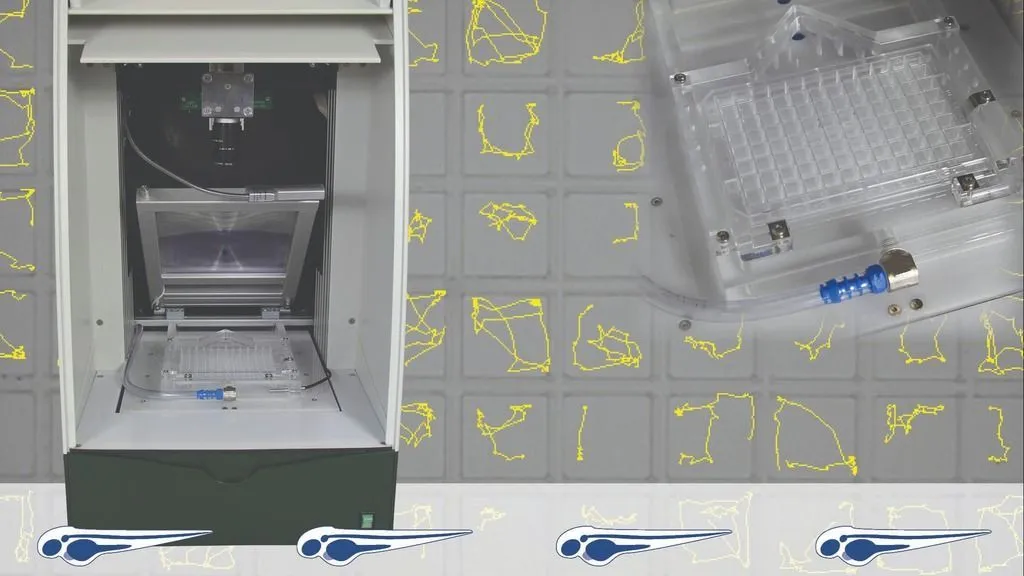DanioVision
Resources and publications
When you choose DanioVision, you’re not choosing tools—you’re choosing research solutions that have been trusted by scientists around the world.
- Technical specifications
- Featured blog posts
- Selected publications

The ins and outs of zebrafish research
Basic behavioral neuroscience in zebrafish
Learn all about the why, when and how regarding zebrafish development and behavior
Daniovision in action
Zebrafish Larvae activity measurement
How do you study locomotor behavior in zebrafish larvae? In this case study we go over the use of zebrafish in Parkinson's disease research. Download the document to learn more about how actual researchers use DanioVision.
Epilepsy research in zebrafish
The development of accurate, high-throughput models for epilepsy research is crucial. Read how researchers use EthoVision XT to develop a multi-parametric analysis in zebrafish.
Eco-neurotoxicity
Many contaminants in our environment have shown to be neurotoxic. Zebrafish are often used to study the effect of toxic compounds on behavior. In this whitepaper you can read about how zebrafish and by extentsion DanioVision are used to facilitate this research.
DanioVision technical specifications
Stay ahead in behavioral research!
Subscribe to Noldus Newsline
- Discover innovations – Be the first to know about new tools and software to advance your research and get insights that help you stay ahead.
- See real research in action – Get inspired by real-world studies from our community, discovering fresh approaches for your work.
- Access exclusive perks – Receive early updates on promotions, product releases, and events crafted for you.
Featured blog posts
How to measure a zebrafish larva’s highly stereotyped response to water motion?
At the Max Planck Institute for Medical Research in Heidelberg, Germany, Groneberg and colleagues researched one of the neural bases for behavior in Danio rerio.
Tracking zebrafish in 3D
Recognizing the lack of hands-on education, Dr. Kalueff has started organizing zebrafish behavioral neuroscience and phenotyping workshops. The workshops have run for over a decades, starting in October 2012.
Getting robust results: one zebrafish is not like the other
Zebrafish larvae locomotor behavior often has a high variability, which can have a big impact on your results. Still, it is one of the most used parameters. So how can you make your study more robust?
Selected DanioVision Publications
Here is a selection of recent papers that mention the use of DanioVision. If you feel your paper should be on this list, please let us know at [email protected]!
- Whyte-Fagundes, P.A., Vance, A., Carroll, A., Figueroa, F., Manukyan, C., Baraban, S. (2024). Testing of putative antiseizure medications in a preclinical Dravet syndrome zebrafish model, Brain Communications, Volume 6, Issue 3. https://doi.org/10.1093/braincomms/fcae135
- Caioni, G., Merola, C., Perugini, M., Angelozzi, G., Amorena, M., Benedetti, E., Lucon-Xiccato, T., Bertolucci., C. (2024). Sodium valproate effects on the morphological and neurobehavioral phenotype of zebrafish. Environmental Toxicology and Pharmacology, Volume 110. https://doi.org/10.1016/j.etap.2024.104500
- Capriello, T.; Consiglio Grimaldi, M.; Cofone, R.; D'Aniello, S.; Ferrandino, I. (2019). Effects of aluminium and cadmium on hatching and swimming ability in developing zebrafish. Chemosphere, 222, 243-249. https://doi.org/10.1016/j.chemosphere.2019.01.140
- Ellström, I.D.; Spulber, S.; Hultin, S.; Norlin, N.; Ceccatelli, S.; Hultling, C.; Uhlén, P. (2019). Spinal cord injury in zebrafish induced by near-infrared femtosecond laser pulses. Journal of Neuroscience Methods, 311, 259-266. https://doi.org/10.1016/j.jneumeth.2018.10.035
Ready to take the next step?
We’re passionate about helping you achieve your research goals. Let’s discuss your project and find the tools that fit.
Contact us